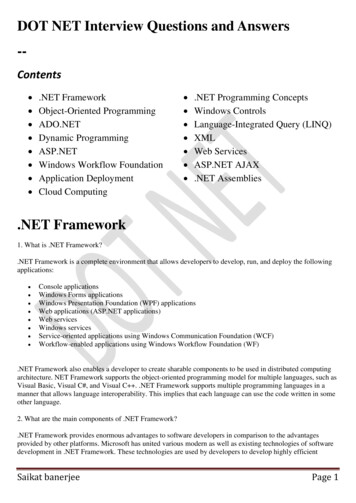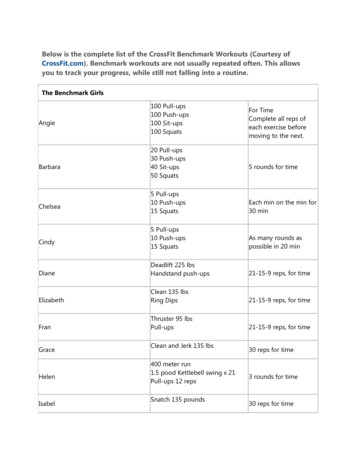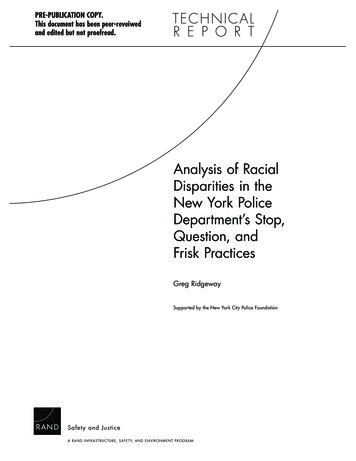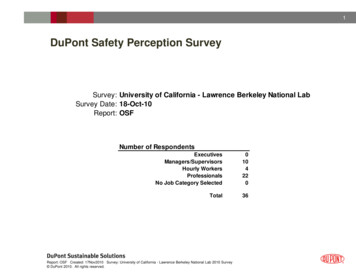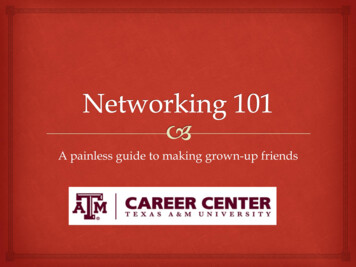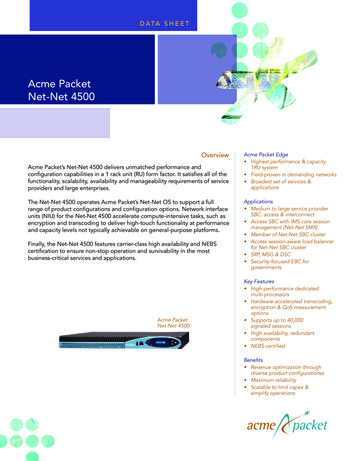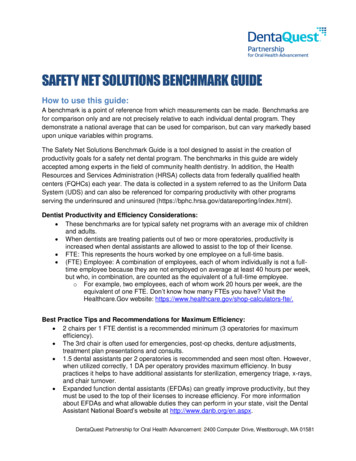
Transcription
SAFETY NET SOLUTIONS BENCHMARK GUIDEHow to use this guide:A benchmark is a point of reference from which measurements can be made. Benchmarks arefor comparison only and are not precisely relative to each individual dental program. Theydemonstrate a national average that can be used for comparison, but can vary markedly basedupon unique variables within programs.The Safety Net Solutions Benchmark Guide is a tool designed to assist in the creation ofproductivity goals for a safety net dental program. The benchmarks in this guide are widelyaccepted among experts in the field of community health dentistry. In addition, the HealthResources and Services Administration (HRSA) collects data from federally qualified healthcenters (FQHCs) each year. The data is collected in a system referred to as the Uniform DataSystem (UDS) and can also be referenced for comparing productivity with other programsserving the underinsured and uninsured entist Productivity and Efficiency Considerations: These benchmarks are for typical safety net programs with an average mix of childrenand adults. When dentists are treating patients out of two or more operatories, productivity isincreased when dental assistants are allowed to assist to the top of their license. FTE: This represents the hours worked by one employee on a full-time basis. (FTE) Employee: A combination of employees, each of whom individually is not a fulltime employee because they are not employed on average at least 40 hours per week,but who, in combination, are counted as the equivalent of a full-time employee.o For example, two employees, each of whom work 20 hours per week, are theequivalent of one FTE. Don’t know how many FTEs you have? Visit theHealthcare.Gov website: est Practice Tips and Recommendations for Maximum Efficiency: 2 chairs per 1 FTE dentist is a recommended minimum (3 operatories for maximumefficiency). The 3rd chair is often used for emergencies, post-op checks, denture adjustments,treatment plan presentations and consults. 1.5 dental assistants per 2 operatories is recommended and seen most often. However,when utilized correctly, 1 DA per operatory provides maximum efficiency. In busypractices it helps to have additional assistants for sterilization, emergency triage, x-rays,and chair turnover. Expanded function dental assistants (EFDAs) can greatly improve productivity, but theymust be used to the top of their licenses to increase efficiency. For more informationabout EFDAs and what allowable duties they can perform in your state, visit the DentalAssistant National Board’s website at http://www.danb.org/en.aspx.DentaQuest Partnership for Oral Health Advancement 2400 Computer Drive, Westborough, MA 01581
PRODUCTIVITY BENCHMARKSDentists 2,500-3,200 encounters/year/FTE dentist1.7 patients/hour or 13.6 patients per 8-hour day2 chairs/dentist (3:1 is ideal)1.5 assistants/dentist (1 DA per chair is ideal)Gross charges 400k- 500k/FTE dentist/yearHygienists 1,300-1,600 encounters/year/FTE hygienist 8-10 patients per 8-hour dayProgram Benchmarks 230 work days/year (after holidays and vacations) 2,700 encounters/year with 1,100 patient baseProcedures/Visit 2.5 CDT coded services/visit Recare visit standard guideline: the period exam,cleaning, fluoride, and any needed radiographswould all be performed at the same visit All sealants needed at one sealant visitDentaQuest Partnership for Oral Health Advancement 2400 Computer Drive, Westborough, MA 01581
Using Benchmarks to Determine Visit Goals: Dentistsand HygienistsProviderTypeVariablesVisits/Hour Capacity Goals for General and Pediatric Dentists BenchmarksNumber ofOperatories1 Operatory(Not Recommended)2 Operatories3 OperatoriesNumber of DentalAssistants1 DA1.5 DA2 DA1 DA1.5DA2 DA2.5DA2DA2.5DA3DAGeneral Dentist1.21.41.51.41.71.9222.22.4Pediatric DentistNANANA1.71.92.12.32.32.63The 1 operatory model is not recommended. This is the least efficient model and is almost alwaysunsustainable. However, since some established clinics already have this model, we have providedbenchmarks for capacity determinations.Instructions for using the chart to determine the appropriate visit per hour benchmark:1. Identify the number of operatories each dental provider works out of.2. Find the number of FTE dental assistants (DAs) staffed in your clinic per provider.3. Choose the provider type you are setting productivity goals for (either Dentist orPediatric Dentist).4. Follow the row of the chosen provider type and match it up with the identified number ofoperatories and DAs. This is your visit per hour benchmark.Example: General dentist works out of 2 operatories with 1.5 FTE DAs. The visit perhour benchmark for a general dentist is 1.7.DentaQuest Partnership for Oral Health Advancement 2400 Computer Drive, Westborough, MA 01581
ProviderTypeVariablesTable Two: Visits/8 hour day Goals for General and Pediatric DentistsNumber ofOperatories1 Operatory(Not Recommended)2 Operatories3 OperatoriesNumber of DentalAssistants1 DA1.5 DA2 DA1DA1.5DA2DA2.5DA2DA2.5DA3DAGeneral Dentist10111211141516161819Pediatric DentistNANANA14151718182124The 1 operatory model is not recommended. This is the least efficient model and is almostalways unsustainable. However, since some established clinics already have this model, wehave provided benchmarks for capacity determinations.Instructions for using the chart to determine the appropriate visits per day benchmark:1. Identify the number of operatories each dental provider works out of.2. Find the number of FTE dental assistants (DAs) staffed in your clinic per provider.3. Choose the provider type you are setting productivity goals for (either Dentist orPediatric Dentist).4. Follow the row of the chosen provider type and match it up with the identified number ofoperatories and DAs. This is your visit per 8 hour day benchmark. Example: Generaldentist works out of 3 operatories with 2.0 FTE DAs. The visit per day benchmark for ageneral dentist is 16.DentaQuest Partnership for Oral Health Advancement 2400 Computer Drive, Westborough, MA 01581
Hygiene Productivity Goals:The productivity benchmark for hygienists is 1-1.2 visits per hour and is not included in thetable because the variables do not apply. In most safety net dental clinics, a hygienist works outof one operatory without a dental assistant.One consideration is patient population; practices with a mix of adults and children should use1.2 as the visit/hour benchmark and clinics mostly serving adults should use 1 visit/hour as thebenchmark for hygienists.Using Benchmarks to Determine Visit Goals: DentalResidents and Dental Student ExternsDental Resident Productivity and Efficiency Considerations: These benchmarks are for typical safety net dental programs providing care to anaverage mix of children and adults. Each dental resident's efficiency will improve over the course of their residency.Improvements are expected with every three months of experience. At the completionof the first year, their productivity should be close to that of a staff dentist. Dental residents do not typically utilize EFDAs.Be sure to check your state's practice act for dental residents.Dental Student Extern Productivity and Efficiency Considerations: These benchmarks are for typical safety net dental programs providing care to anaverage mix of children and adults. Fourth year dental student externs typically provide care to no more than approximatelyone patient every 75 minutes - 2 hours. This means in an eight-hour day they wouldsee a maximum of 4-6 patients. Dental student externs either work alone or with one dental assistant. Staff dentists providing supervision of dental students may be required to becomeadjunct faculty at the students’ dental school. Programs that utilize dental students may experience slightly reduced productivity andefficiency for the staff dentists tasked with providing supervision.Dental student externs have extremely limited productivity which inhibits access to care;therefore, safety net dental programs considering becoming a teaching health center fordental student externs should have a minimum of 7 operatories. (Some expertsconsider 10 to be the minimum.)A good reason to consider utilizing dental students is to introduce future dentists to thedental safety net and your program.SNS recommends a minimum of 6 week student rotations.Be sure to understand your state's practice act for dental student externs.DentaQuest Partnership for Oral Health Advancement 2400 Computer Drive, Westborough, MA 01581
Provider TypeVariablesTable Three: Visit/Hour Capacity Goals for Dental ResidentsNumber of Operatories1 Operatory2 OperatoriesNumber of Dental Assistants1 DA1.5 DA1 DA1.5 DA2 DAGPR Resident, Q11NANANANAGPR Resident, Q211.11.11.2NAGPR Resident, Q311.31.21.4NAGPR Resident, Q41.11.41.31.51.6Provider TypeVariablesTable Four: Number of Visits/8-Hour Day Goals for Dental ResidentsNumber of Operatories1 Operatory2 OperatoriesNumber of Dental Assistants1 DA1.5 DA1 DA1.5 DA2 DAGPR Resident, Q18NANANANAGPR Resident, Q289910NAGPR Resident, Q38101011NAGPR Resident, Q4911101213DentaQuest Partnership for Oral Health Advancement 2400 Computer Drive, Westborough, MA 01581
2016 UDS* NATIONAL DATA AVERAGES2,614 visits/year/FTE dentist1,231 visits/year/FTE dental hygienist534 visits/year/FTE dental therapist2.6 visits/year per unduplicated dental patientAverage cost/visit in dental 191/visitAverage admin cost allocation to dental 12.4%Sealant metric average 48.7%*Uniform Data System (UDS) - A federal system used to track a core set of informationappropriate for reviewing the operation and performance of Health Centers, including patientdemographics, services provided, staffing, clinical indicators, utilization rates, costs andrevenues. UDS data is collected annually and required by HRSA for all Federally QualifiedHealth Centers.Source: aQuest Partnership for Oral Health Advancement 2400 Computer Drive, Westborough, MA 01581
DentaQuest Partnership for Oral Health Advancement 2400 Computer Drive, Westborough, MA 01581 PRODUCTIVITY BENCHMARKS . Identify the number of operatories each dental provider works out of. 2. Find the number of FTE dental assistants (DAs) staffed in your clinic per provider. 3. Choose the provider type you are setting productivity goals .
